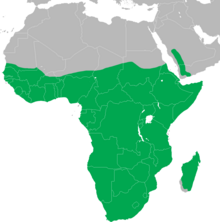| Hamerkop | |
|---|---|

| |
| In Kenya | |
| Scientific classification | |
| Domain: | Eukaryota |
| Kingdom: | Animalia |
| Phylum: | Chordata |
| Class: | Aves |
| Order: | Pelecaniformes |
| Family: | Scopidae |
| Genus: | Scopus |
| Species: | S. umbretta
|
| Binomial name | |
| Scopus umbretta Gmelin, 1789
| |

| |
| Range of the hamerkop | |

The hamerkop (Scopus umbretta) is a medium-sized wading bird. It is the only living species in the genus Scopus and the family Scopidae. The species and family was long thought to sit with the Ciconiiformes but is now placed with the Pelecaniformes, and its closest relatives are thought to be the pelicans and the shoebill. The shape of its head with a long bill and crest at the back is reminiscent of a hammer, which has given this species its name after the Afrikaans word for hammerhead. It is a medium-sized waterbird with brown plumage. It is found in Africa, Madagascar and Arabia, living in a wide variety of wetlands, including estuaries, lakesides, fish ponds, riverbanks, and rocky coasts. The hamerkop is a sedentary bird that often shows local movements.
The hamerkop takes a wide range of prey, mostly fish and amphibians, but shrimps, insects and rodents are taken too. Prey is usually hunted in shallow water, either by sight or touch, but the species is adaptable and will take any prey it can. The species is renowned for its enormous nests, several of which are built during the breeding season. Unusually for a wading bird the nest has an internal nesting chamber where the eggs are laid. Both parents incubate the eggs, and raise the chicks.
The species is not globally threatened and is locally abundant in Africa and Madagascar,. The International Union for Conservation of Nature (IUCN) has assessed it as being of least concern.
- ^ BirdLife International (2016). "Scopus umbretta". IUCN Red List of Threatened Species. 2016: e.T22697356A93610351. doi:10.2305/IUCN.UK.2016-3.RLTS.T22697356A93610351.en. Retrieved 19 November 2021.
